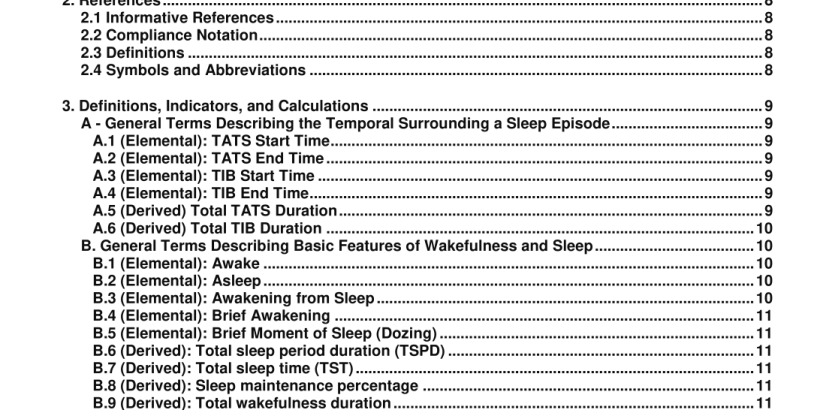ANSI CTA 2052.1-2016 pdf download.Definitions and Characteristics for Wearablea Sleep Monitors
-Terms in Category A: We begin by defining terms describing a sleep episodes temporal surround. These are general terms related to the sleeper’s intention and their position in the environment. Because a person may be in bed without an intention to sleep leads to the distinction between these two elements.
-Terms in Category B: Terminology in category B consists of terms used to describe the general sequence of events once there is an intention to sleep. Continued wakefulness and eventual sleep will occur. Furthermore, once sleep has occurred, there can be awakenings. If a person has a very brief sleep episode surrounded by wakefulness, a dozing episode can be considered. It should be noted that some of the terms in category B have both general and laboratory definitions. However, terms such as wakefulness do not require polysomnographic comparison to verify (e.g., I am awake while I am typing this document). Such terms have and can be defined using other criteria. Such terms include, but are not limited to: wakefulness, sleep, and awakening. Once sleep and wakefulness episodes are detected, many parameters can be calculate (e.g., total sleep period duration, total sleep time, and number of awakenings).
-Terms in Category C: Once the initial sleep and final wakefulness episode has been detected, it is possible to calculate several important metrics based on the relationship between these measures and the temporal surround. These include latency to sleep onset, latency to arising, and sleep efficiency.
-Terms in Category D: Standards for sleep features shown in category D are defined in the “AASM manual for the scoring of sleep and associated events: rules, terminology and technical specifications. 1st edition” (Iber et al, 2007) and updated in the “American Academy of Sleep Medicine. The AASM Manual for the Scoring of Sleep and Associated Events: Rules, Terminology, and Technical Specifications, Version 2.2 (Berry et al., 201 5). This sleep feature nomenclature is well established and widely used by sleep researchers and sleep medicine practitioners. These standards are based on polysomnographic (electroencephalogram, electrooculogram, and electromyogram) correlates derived from normal human subjects. To avoid creating linguistic ambiguity, these terms should concord with standardized definitions and will not be redefined here. It should be noted that the Standardized Manual also defines abnormal respiratory, movement, and cardiac events used in diagnostic practice. Definitions for these sleep pathophysiologies are beyond the scope of this document and should concord with existing nomenclature.
-Terms in Category E: In the present document, terminology is proposed in category E to extend sleep feature description beyond existing standard nomenclature. Alternative terminology is recommended to avoid creating ambiguity with existing polysomnographic nomenclature (provided in category D). Care was taken to avoid using sleep medicine laboratory terminology in order to avoid confusion. As biosensor technology advances, the specifics of these terms will likely evolve.
-Terms in Category F: Terminology used to describe circadian rhythms is included here. Actigraphs, using accelerometers usually worn on the wrist and resembling a wrist-watch, have long been used in circadian rhythm research. Such devices are currently being used in the Human Sleep Genome Project. Each actigraph differs with respect to their precision and accuracy and should be evaluated for its performance characteristics. Recommended terminology and definitions are provided herein.ANSI CTA 2052.1-2016 pdf download
